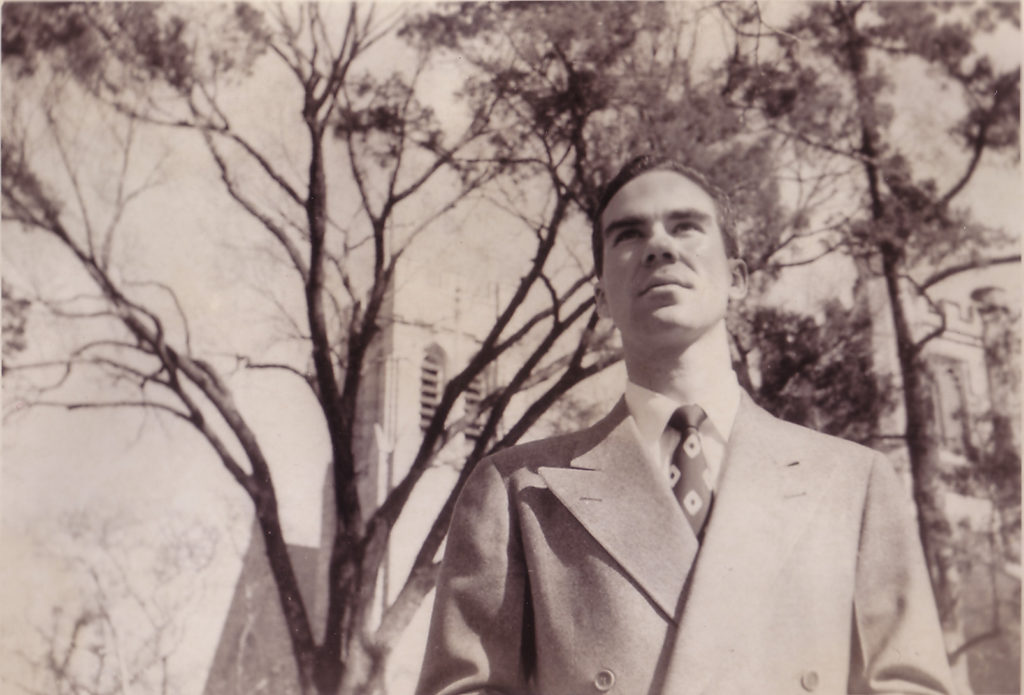Streambeds act as natural water filters by trapping particles and pollutants. To better understand the dynamics of these small yet complex systems, a UNC hydrologist is creating (and clogging) her own stream.

The basement of Chapman Hall is a maze. Wind through several hallways, swipe a UNC OneCard to gain access through a heavy, locked door, and enter the massive chamber of the Joint Applied Math and Marine Sciences Fluids lab.
Turn left, walk past the wind tunnel and the towering 36-meter wave tank, and you’ll see hundreds of gallons of water swirling threw an elevated metal structure. Kaylyn Gootman, a PhD candidate in the Curriculum in Environment and Ecology, dumps a large plastic bag full of what looks like flour into the water and watches closely as the contents disperse.
The large oval-shaped metal structure, called a racetrack flume, holds approximately 430 gallons of water, the equivalent of about eight bath tubs. Using an electric trolling motor and an Acoustic Doppler Velocimeter (ADV), Gootman can control the direction and speed of the water. The material that looks like flour is actually finely ground clay — and Gootman is very interested in how it moves.
Gootman calls the set-up a “mock stream.”
“We’re studying the physical impact of a natural pollutant — like how much clay gets embedded in a streambed — and the natural clean-up processes that the water circulation of a stream provides,” she says.
Water movement is complex — in a natural stream, water flows up, down, and all around. To understand the whole system, Gootman, and her undergraduate assistant Savannah Swinea, are examining the individual processes of a stream they built here in the fluids lab.
“Being able to narrow our focus to major physical controls allows us to study a few key processes without much interference,” Gootman says. “That knowledge can then act as a foundation for better understanding in the natural environment where things happen in multiple directions and dimensions all at once.”
Constructing a stream
Think of a streambed as a kidney. “Kidneys filter blood, and streams filter water — both trap toxins,” Gootman says. While kidneys filter toxins like alcohol, streams break down particles from surface water runoff including pollutants from irrigation, construction, or industrial agriculture. But just as kidneys can fail, so can streams — a kidney stone is akin to a clogged streambed.
Gootman’s research can help geoscientists, developers, and land owners better understand erosion events, especially as they relate to urbanization. How much pollution can a stream filter before the system gets overwhelmed?
Working in the fluids lab allows her to save time and resources — and she’s not harming the environment. “Going out to a stream and dumping a bunch of clay in it would not be very good environmental stewardship,” Gootman says with a smile.
Using a contained system like the racetrack flume also gives her the ability to obtain precise measurements. She can focus on one particular direction of water movement, like down-welling, or the downward flow of water into the streambed. Examining each parameter individually simplifies the inherently complex nature of fluid dynamics.
Obstructing a stream

Turbidity, or the level of “cloudiness” in the water, is another important indicator when measuring quality — but it’s a difficult measurement to obtain in natural streams. “The most accurate way to measure turbidity is to take samples, then go back to the lab to filter them,” Gootman says. “And you have to do that a lot. It’s really expensive and time consuming.”
But there are other methods for measuring turbidity, including optical sensors. “Optical back scatter” is a technical term used by hydrologists that refers to the use of light to determine how much material is in a body of water. Optical backscatter sensors (OBS) emit infrared light into the water column. As soon as the light comes into contact with suspended particles, it bounces back to the sensor. Faster signals indicate more particles in the water.
Gootman and other hydrologists measure the optical back scatter in river networks all over the world, but no two rivers are the same. “It’s very location specific work — a calibration for the Haw River is different from the Mississippi,” she says. “That’s another advantage of working in the fluids lab — we can make these kinds of calibrations more accurately and easily than we can in the field.”
Decoding the data
The value of this kind of high-tech instrumentation is it records every tiny signal — the downside is it records a lot of data. On paper, it looks like a jumbled mess. “The instrumentation is so sensitive it’s almost like earthquake data,” Gootman says. To make sense of it, Gootman meets with UNC’s resident earth science data expert and chair of the Department of Geological Sciences, Jonathan Lees. “He’s helped me discern the signal from the noise,” she says.
In addition to decoding her backscatter data, Gootman analyzes the migration of clay particles by examining sediment cores. “How deep clay particles travel into the streambed tells us a lot about the physics of the water in the stream,” she says. “You might not think that a tiny thing like bits of clay could have a large impact but enough of it over a certain amount of time could.”
Gootman and Swinea spend hours separating the sediment cores by hand in the lab — but that only gets them so far. Fortunately, Gootman can borrow a laser particle size analyzer from Laura Moore, director of the UNC Coastal Environmental Change Lab.
In addition to utilizing the resources and expertise of the Department of Geological Sciences, Gootman also collaborates with faculty in math, physics, and marine sciences. “This is inherently collaborative work,” she says. “And it has also afforded me the opportunity to be a mentor.”
Blazing a trail

As a junior pursuing a major in environmental science and a minor in marine science, Swinea knew she wanted to get experience with hands-on research.
“I was looking for research opportunities for the summer and realized that UNC has a program for students in the geosciences from underrepresented communities,” Swinea says. The IDEA Undergraduate Research Experience, a program funded by the National Science Foundation, matched Swinea with Gootman and the two women have created a strong partnership.
The collaboration has given Swinea experience and research skills she didn’t have before this past summer. “Learning how to program a probe or use a test tube is useful, but the biggest things I’ve learned from Kaylyn are being adaptable and being patient — those are overarching qualities that you don’t necessarily learn in a class.”
Swinea’s enthusiasm and eagerness to learn also inspires Gootman. “It’s really cool to see a woman who is younger than me on the early part of her scientific path,” she says. “Savannah is a great student — she’s curious, she’s a quick learner and she’s not afraid to ask for help when she’s stuck. And she’s getting started with research much earlier than I did.”
One of the greatest strengths of their work together, and one of the most vital things for Swinea, has been seeing herself in Gootman. Because Gootman also went to UNC for undergrad, Swinea can visualize a similar trajectory for herself. “Kaylyn has given me a lot of advice about academia and grad school and life decisions,” she says. “What’s kept me on the science path is not only teachers and peers encouraging me — it’s being able to see myself in the future.”
As Swinea contemplates the possibilities associated with a career in science, Gootman considers impact of the research they’re currently conducting together. “There are lots of things happening to our rivers and streams as housing developments and commercial developments increase,” she says.
The work Gootman and Swinea are doing in the fluids lab will one day help inform issues like bank erosion, excess runoff, and water quality. “Our data provides information on the baseline physical dynamics of streams — how water functions as a filter,” Gootman says. “Having that information on hand can help us target places to study out in the real world.”
Kaylyn Gootman is a PhD candidate in the Curriculum in Environment and Ecology.
Savannah Swinea is an undergraduate pursuing a major in environmental science and a minor in marine science. She was a 2017 recipient of the IDEA Program, administered by the UNC Institute for the Environment.
The Joint Applied Math and Marine Sciences Fluids lab is supported by the National Science Foundation, Office of Naval Research, National Institutes of Health, and UNC College of Arts and Sciences. The racetrack flume is owned by three principal investigators, including Brian White, Rich McLaughlin, and Roberto Camassa.
Story by Mary Lide Parker for endeavors magazine.




